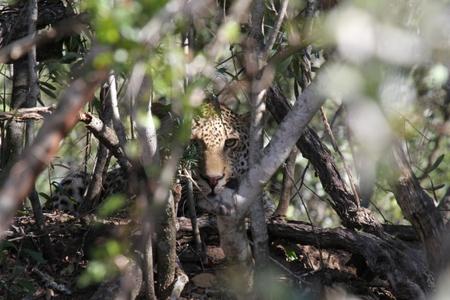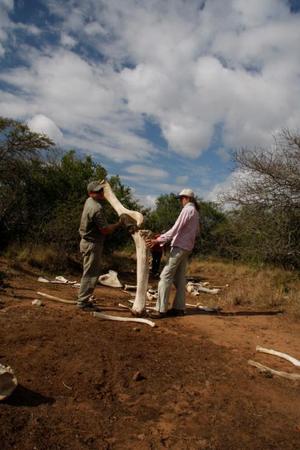We arrived at Phinda a day late after being held up by extensive roadworks on the road from Johannesburg. We were greeted by Tristan Dickerson (project manager) and PhD student Julian Fattebert, who helped us to get settled in and told us all about the project. The next day we set six traps in the northern portion of the reserve. It was interesting to see how the Phinda team had adapted the trapping method to suit their area, and Quinton and I spent much time embroiled in fairly technical conversations with Tristan about the best ways of catching leopards! This was the life!

Figure1 . Sighting of a leopard! An unusual event for researchers in the Cape.
It was essential that we checked the traps very frequently, as this is the safest method of trapping any animals and so that we could respond quickly to any capture. To do this we fitted each trap with a transmitter that we could use to check the trap by radio. We then slept out on top of the water reservoirs for Phinda’s Hilltop Camp; this had the benefit of being a high point from which we could check the traps as well as ensuring that we were safe from lions and hyenas! Traps were monitored at least every 90 minutes and traps set only at night.
Our first night of trapping was uneventful; the traps were triggered by genets, honey badgers, and other small animals, but nothing was actually captured due to the way in which these traps work. We were therefore unexpectedly well-rested when we set off with Julian to track some leopards. The Phinda area is relatively flat with some low, rolling hills, and because leopards live at much higher densities there tracking leopards is much easier than in the mountains of the Cape! After a few near-misses where we got close to leopards that were in dense, impenetrable vegetation, we finally managed to spot one near a watering hole. The leopard, a young male, regarded us coolly from the top of a termite mound before melting away into the bush. It was a wonderful encounter, especially for us Cape researchers who very rarely see our study animals! Julian, in stark contrast, told me that a few months earlier he’d had nine leopards collared, five of which he could sight on a near-daily basis!

Figure 2. Elizabeth and Tristan “throwing the bones” – maybe we would catch a leopard...
On our second night of trapping we struck gold. We had just reached the campsite after setting the traps, and Julian was testing to see that he could pick up the radio signals from all the traps when he found that one had been triggered. Certain that it was a malfunctioning transmitter, Tristan went off to replace it while we set up camp and started to prepare supper. To everyone’s surprise, we then got a call from Tristan saying that we’d actually caught a leopard!

Figure 3. Gareth in awe of a “Real” leopard – Shesha, just over 2 yrs old and 55kg already!
The leopard was a young male, but at 55kg still a good deal larger than what we’re used to in the Cape! He was extremely calm and quiet in the trap, only really becoming aggressive after suffering the indignity of being darted. Once the drugs had taken effect, we were able to approach him and see what a magnificent animal he was – powerful despite his youth, and in excellent condition.
After taking measurements and fitting him with a collar, we remained close by to ensure that he was able to recover unmolested. Fortunately the area remained quiet and in due course the leopard crept away. We named him ‘Shesha’, which is the Zulu word for ‘quick’, which seemed appropriate given how quick we caught him!
The traps were quiet for the remainder of the night, although morning once again brought plenty of evidence of bait theft by genets and honey badgers. We set off with Julian in search of Shesha, and located him several hundred metres away from where he’s been captured on the other side of the river. While we weren’t able to actually see him, the distance that he’d moved suggested that he’d largely recovered from his ordeal.
Shesha’s capture was to prove the highlight of our trip, with no other animals being captured on our final night of trapping (we did have a great view of the lunar eclipse though). The following day we packed our bags and rather sadly left Phinda. It was wonderful to have the opportunity to visit such a beautiful place, and we certainly learnt a lot from the experience. We would like to thank Tristan and Julian for their fantastic hospitality, as well as everyone else at Phinda who helped to make our visit so memorable, as well as Dr Guy Balme (Panthera) for arranging the trip for us.

Figure 4. Greetings from Shaka Country – treated to a beautiful eclipse.















